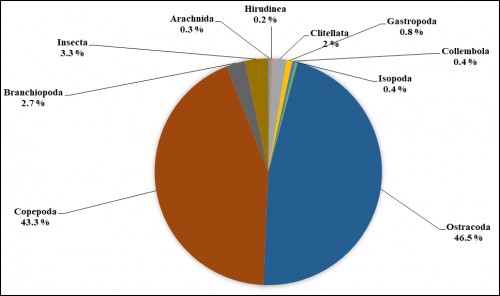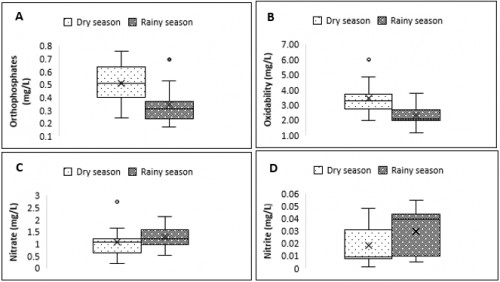International Journal of Fisheries and Aquatic Studies
2019, Vol. 7, Issue 6, Part A
Impact of physicochemical parameters on biodiversity and groundwater quality in Tiko, Cameroon
Author(s): Chinche Sylvie Belengfe, Zebaze Togouet Serge Hubert, Moanono Patrick Georges Thiery, Pountougnigni Oumarou F, Tuekam Kayo Raoul Polycarpe and Fomena Abraham
Abstract: In order to evaluate the impact of physicochemical variation on biodiversity in ten wells in the town of Tiko, physico-chemical parameters of the well water were analyzed using standard methods while their fauna were collected using a phreatobiological net. The physicochemical analysis showed that, the well water in Tiko had high temperature (27 ± 0.84 °C), slightly acidic pH (6.42 ± 0.45 CU), highly turbid (13.55 ± 8.7 FTU), high orthophosphate levels (0.53 ± 0.45 mg/L), good dissolved oxygen level ( 59.57 ± 6.48 %), weak mineralization ( 256.75 ± 104.52 µS/ cm) with high colour content (32.17 ± 13.35 Pt/Co), with all the values being relatively higher in the dry season than in the rainy season except for colour. A total number of 6290 organisms were collected during the study period in the sampling points, belonging to 02 phyla, 09 classes, 29 families and 26 identified genus/or sub families. This community was dominated by Ostracods (46.51%) followed by Copepods (43.3 %) while the least taxa were Hirudinea (0.24 %) and Arachnids (0.35 %). Groundwater was rich in mostly epigean taxa and very poor in groundwater dependent organisms (hypogean taxa) due to the poor management and protection levels of the wells and also due to the relationship between ground water and surface water. A total of 43 stygobites were collected, belonging to the families Asellidae (01), Stenasellidae (20) and Darwinulidae (22). The results obtained showed that the water is not good for consumption by the population without treatments. There is therefore need to sensitize these population on the development of positive habits towards their water points in order to prevent them from water borne diseases that could be caused by the poor physicochemical properties.
Related Graphics: Click here for more related graphics: Fig. 1:
Fig. 1: Distribution of the different classes of the 6290 invertebrates collected in groundwater during the sampling period in the wells in Tiko.
 Fig. 2:
Fig. 2: Boxplots showing the seasonal distribution of dissolved oxygen (A) and dissolved carbon dioxide (B) in the wells studied in Tiko
 Fig. 3:
Fig. 3: Boxplots showing the seasonal distribution of orthophosphate (A), oxidability (B), nitrate (C) and nitrite (D) in the wells studied in Tiko
Click Here
How to cite this article:
Chinche Sylvie Belengfe, Zebaze Togouet Serge Hubert, Moanono Patrick Georges Thiery, Pountougnigni Oumarou F, Tuekam Kayo Raoul Polycarpe, Fomena Abraham. Impact of physicochemical parameters on biodiversity and groundwater quality in Tiko, Cameroon. Int J Fish Aquat Stud 2019;7(6):39-46.



